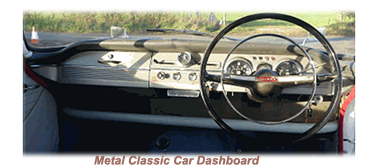
 Another potentially problematic area in a classic car is the dashboard, which can become faded, usually as a result of constant exposure to changes in temperature and humidity.
Another potentially problematic area in a classic car is the dashboard, which can become faded, usually as a result of constant exposure to changes in temperature and humidity.
 The dashboards of cars are made up of numerous plastic layers. Older car dashboards typically include a top layer constructed of PVC, sometimes known as polyvinyl chloride. If PVC is not properly cared for and protected, it may begin to crack after a few years of exposure to heat and sunshine.
The dashboards of cars are made up of numerous plastic layers. Older car dashboards typically include a top layer constructed of PVC, sometimes known as polyvinyl chloride. If PVC is not properly cared for and protected, it may begin to crack after a few years of exposure to heat and sunshine.
After many years of exposure to the sun, the dashboards of older automobiles, especially classics, tend to grow brittle and break. Even if the dashboard has undergone a full restoration, and the most up to date protective coverage has been applied, it will still be susceptible to dashboard fractures if exposed to excessive UV light. Plastics like PVC have chemical components that are sensitive to ultraviolet radiation.
Oils can evaporate, and the molecules of plastic can be broken down over time by ultraviolet radiation. This will cause dashboard plastic to dry out and break, especially if regularly exposed to ultraviolet light.
The chemical compounds in the dashboard can degrade after prolonged exposure to heat, such as when a car is parked outside, and the dash is exposed to sunshine coming through the windscreen. On a sunny day, after roughly an hour of exposure, the interior of an automobile can reach high temperatures. The signs that exposure to ultraviolet radiation has harmed the dashboards will show if they appear dry, dusty, or powdery.
 In the event that the dashboard does crack, all is not lost as some of the smallest cracks can be repaired. If the cracks are lengthy and extensive, the dashboard must be completely replaced.
In the event that the dashboard does crack, all is not lost as some of the smallest cracks can be repaired. If the cracks are lengthy and extensive, the dashboard must be completely replaced.
 A temporary cure is to fill the crack with silicon or use a dashboard crack repair kit, both of which are readily accessible at most auto parts stores.
A temporary cure is to fill the crack with silicon or use a dashboard crack repair kit, both of which are readily accessible at most auto parts stores.
To stop the PVC from drying out, treat the dashboard with a moisturising agent. Pick a remedy that has sunscreen in it to block UV rays.
Wooden dashboards are made up from a large flat slab of wood that has been straightened over a long period of time. Sixties cars in particular had dashboards made of plywood, layers of wood joined in a criss- cross pattern, allowing the grain to expand and contract effectively, with each layer keeping the next in check. Most of the woods used as veneers in car interiors are either birch, mahogany, or burl walnut.
Dashboard veneers are literally as thick as a playing card, glued to plywood, meaning that resurfacing a veneered dashboard requires more care, especially when it comes to sanding.
Maintaining a classic car dashboard, be it wood, plastic and even metal wil help preserve the integrity and appearance of the vehicle, just like the steering wheel. Here are a few tips on how to properly care for a classic car dashboard:
![]() . Avoid using harsh chemicals or abrasives, as these can damage the dashboard's finish.
. Avoid using harsh chemicals or abrasives, as these can damage the dashboard's finish.
![]() use a wood polish to keep the dashboardlooking like new. Be sure to use a polish that is appropriate for the type of wood the dashboard is made from.
use a wood polish to keep the dashboardlooking like new. Be sure to use a polish that is appropriate for the type of wood the dashboard is made from.
 Since interior wood trim is frequently covered in acrylic, any cleaning agent safe for plastic surfaces can be used on this area of your car.To prevent scratching the surface as well, use a microfiber cloth rather than a paper towel.
Since interior wood trim is frequently covered in acrylic, any cleaning agent safe for plastic surfaces can be used on this area of your car.To prevent scratching the surface as well, use a microfiber cloth rather than a paper towel.

![]() , use a protectant specifically made for that material. These products can help keep the dashboard from cracking and fading. If the dashboard has a leather finish, use a leather conditioner to keep it supple and prevent cracking.
, use a protectant specifically made for that material. These products can help keep the dashboard from cracking and fading. If the dashboard has a leather finish, use a leather conditioner to keep it supple and prevent cracking.
It should never be forgotten that maintaining the dashboard of the car is as important as maintaining the exterior and engine, affecting the overall appearance and feel of the car.
int4




